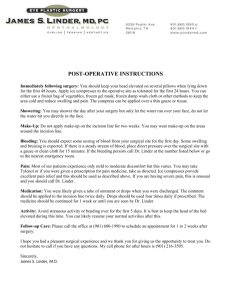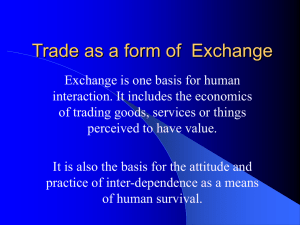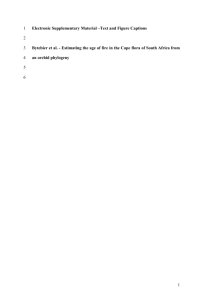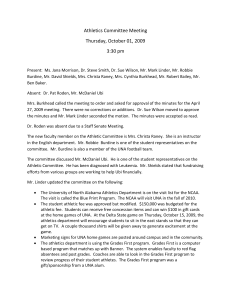An Empirical Analysis of the Linder Theory of
advertisement
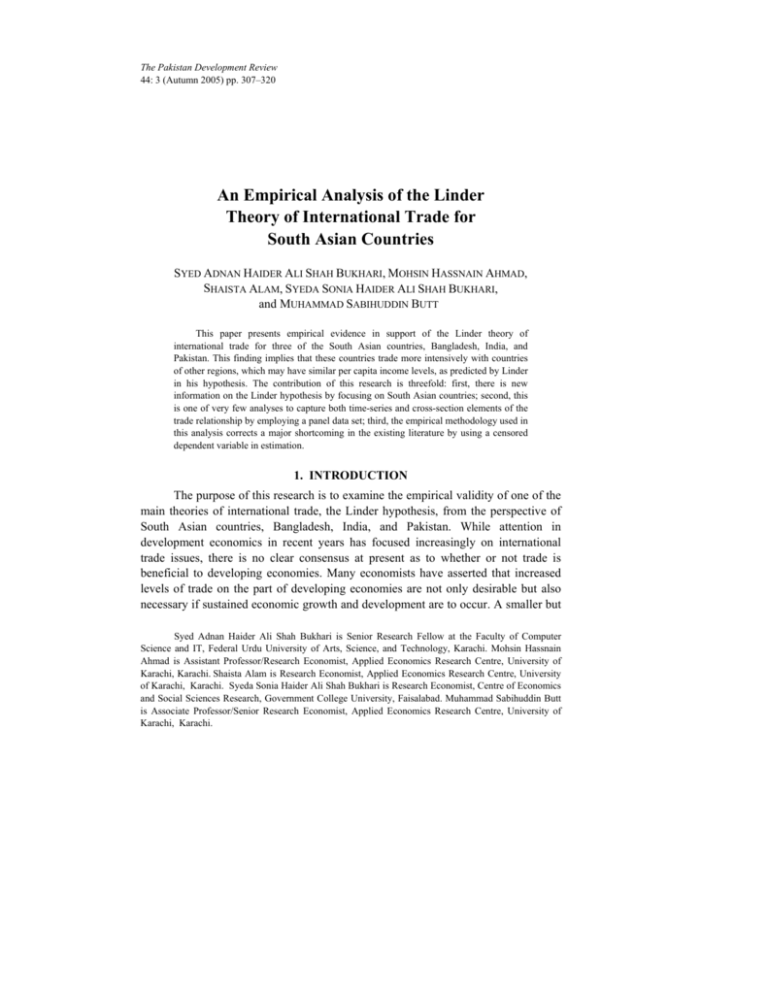
The Pakistan Development Review 44: 3 (Autumn 2005) pp. 307–320 An Empirical Analysis of the Linder Theory of International Trade for South Asian Countries SYED ADNAN HAIDER ALI SHAH BUKHARI, MOHSIN HASSNAIN AHMAD, SHAISTA ALAM, SYEDA SONIA HAIDER ALI SHAH BUKHARI, and MUHAMMAD SABIHUDDIN BUTT* This paper presents empirical evidence in support of the Linder theory of international trade for three of the South Asian countries, Bangladesh, India, and Pakistan. This finding implies that these countries trade more intensively with countries of other regions, which may have similar per capita income levels, as predicted by Linder in his hypothesis. The contribution of this research is threefold: first, there is new information on the Linder hypothesis by focusing on South Asian countries; second, this is one of very few analyses to capture both time-series and cross-section elements of the trade relationship by employing a panel data set; third, the empirical methodology used in this analysis corrects a major shortcoming in the existing literature by using a censored dependent variable in estimation. 1. INTRODUCTION The purpose of this research is to examine the empirical validity of one of the main theories of international trade, the Linder hypothesis, from the perspective of South Asian countries, Bangladesh, India, and Pakistan. While attention in development economics in recent years has focused increasingly on international trade issues, there is no clear consensus at present as to whether or not trade is beneficial to developing economies. Many economists have asserted that increased levels of trade on the part of developing economies are not only desirable but also necessary if sustained economic growth and development are to occur. A smaller but Syed Adnan Haider Ali Shah Bukhari is Senior Research Fellow at the Faculty of Computer Science and IT, Federal Urdu University of Arts, Science, and Technology, Karachi. Mohsin Hassnain Ahmad is Assistant Professor/Research Economist, Applied Economics Research Centre, University of Karachi, Karachi. Shaista Alam is Research Economist, Applied Economics Research Centre, University of Karachi, Karachi. Syeda Sonia Haider Ali Shah Bukhari is Research Economist, Centre of Economics and Social Sciences Research, Government College University, Faisalabad. Muhammad Sabihuddin Butt is Associate Professor/Senior Research Economist, Applied Economics Research Centre, University of Karachi, Karachi. 308 Bukhari, Ahmad, Alam, Bukhari, and Butt equally vociferous group insists that trade only deepens the dependency of developing countries on the developed world and, in so doing, ensures continued under-development. Whatever the effect of trade on the developing world, it is indisputable that trade has been expanding in most developing countries in recent years [see United Nations (2004)]. It is essential, therefore, to gain an understanding of the existing trade patterns in developing countries and to gain an insight into how these patterns are changing. The contributions of this paper lie in its attention to three factors. First, we consider the Linder hypothesis in the context of developing countries. The application of the Linder theory to developing economies has been neglected in the existing literature despite the growing need to understand the increasing levels of trade occurring in these countries. Second, our research extends the existing literature by estimating a fixed-effects panel data model. This methodology not only allows us to examine the validity of the Linder theory over a large number of countries but, also, allows us to capture relevant trends that have occurred over time. Despite the tremendous advantage that the use of panel data offers, relatively few analyses have employed data of this nature; only Thursby and Thursby (1987) have previously used combined time-series and cross-section data in studying the empirical validity of the Linder hypothesis. Third, our analysis makes use of a censored dependent variable in order to properly measure the economic behaviour of all potential trading partners. This approach corrects a methodological shortcoming of previous analyses in which the magnitude of the Linder effect has been over or under estimated through the exclusion of information on those countries that have a zero or negative desire to export to a given country. The failure to model the Linder theory in this context must call into question the econometric validity of existing empirical work in this area. Our analysis presents new and more accurate empirical evidence to explain existing trade patterns in developing countries. The plan of the rest of this paper is as follows. The next section discusses the Linder hypothesis and its relationship to the competing “factor-proportions” theory. Section 3 reviews the existing literature on the empirical validity of the Linder hypothesis. Section 4 presents the econometric model used in our analysis and also discusses the fixed-effects Tobit estimation procedure employed here. A discussion of the empirical results is contained in Section 5. The final section offers conclusions and suggestions for future research. 2. REVIEW OF RELEVANT LITERATURE 2.1. Theoretical Perspective Some of the most basic questions that trade theory attempts to address involve patterns of trade: what determines why a country exports and imports certain goods, and with what countries does it exchange these goods? Since the early part of this International Trade for South Asian Countries 309 century, the most widely used theory employed the factor proportions model. Eli Heckscher1 pioneered this model in 1919, and Bertil Ohlin2 in 1933 and Paul Samuelson3 in 1949 subsequently amended it. This model posits that patterns of trade are determined by differences in relative factor proportions. In short, countries that are relatively well endowed with labour will tend to export goods that use labour relatively intensively in their production, while relative capital abundance implies relatively capital-intensive exports. This model, then, suggests that the pattern of trade is largely a supply-side phenomenon. This model posits that patterns of trade are determined by differences in relative factor proportions. In short, countries that are relatively well endowed with labour will tend to export goods that use labour relatively intensively in their production, while relative capital abundance implies relatively capital-intensive exports. This model, then, suggests that the pattern of trade is largely a supply-side phenomenon. The Heckscher-Ohlin-Samuelson (HOS) model has been challenged in several ways. Leontief4 (1953), in examining import and export data from the United States in 1947, discovered that U.S. exports are on average relatively labour intensive while U.S. imports are relatively more capital intensive. Since the U.S. was and is widely perceived to be a capital abundant country relative to almost any other country, this finding seemed to contradict the HOS model and became known as the “Leontief Paradox”. Some evidence regarding the developing-country case comes from Bharadwaj5 (1962) who found that the HOS model does not adequately explain bilateral trade between the U.S. and India. Bowen, Leamer and Sveikavskas6 (1995) conclude from their study of 27 countries (some of which are developing countries) that the Heckscher-Ohlin model explains observed patterns of trade rather poorly. Even the studies that have found support for the Heckscher-Ohlin model have come under fire for data and methodology problems. Deardorff7 (1984) states that the basic 1 Heckscher, E. F. (1950) The Effect of Foreign Trade on the Distribution of Income. In American Economic Association (Chapter No. 13). 2 Ohlin, B. (1933) Interregional and International Trade. Cambridge: Harvard University Press. 3 Samuelson, P. A. (1949) International Factor Price Equalisation Once Again. Economic Journal 59:234, 181–97. 4 Leontief, W. W. (1953) Domestic Production and Foreign Trade: The American Capital Position Re-examined. In J. Bhagwati (ed.) International Trade: Selected Readings. Middlesex, England. Penguin Books. 5 Bharadwaj, R. (1962) Factor Proportions and the Structure of Indo-U.S. Trade. Indian Economic Journal 10: (October), 105–16. 6 Bowen, H. P., E. E. Leamer, and L. Sveikavskas (1995) Multicountry, Multifactor Tests of the Factor Abundance Theory. In J. P. Neary (ed.) International Trade: Structure, Trade and Growth, Vol. 2. Brookfield, Vermont, Edward Elgar, 269–87. 7 Deardorff, A. V. (1984) Testing Trade Theories and Predicting Trade Flows. In R. W. Jones and P. B. Kenen (eds.) Handbook of International Economics. Amsterdam, I.: Elsevier Science Publishers. 310 Bukhari, Ahmad, Alam, Bukhari, and Butt model is useful in understanding the commodity composition of international trade, but it is otherwise “fairly helpless”. Other researchers have noted that the HOS model suggests that a great deal of trade should occur between the developed and the developing world, since the differences in capital-labour ratios would be widest in such cases. However, the fact that the majority of international trade is conducted between developed countries, which typically have very similar factor endowments, seems to call into question the validity of this theory. Finally, there are also theoretical reasons to question the validity of the factor-proportions theory as it pertains to developing countries. Many of the underlying assumptions of the factor-proportions theory are not likely to be satisfied in developing economies. For example, the assumptions of full employment, perfect factor mobility and identical technology across countries are largely untenable in the developing-country setting. While some researchers have attempted to broaden the HOS model so that it better explains the stylised facts, others have developed alternative models. One such alternative was the theory proposed by Linder8 (1961). In contrast with the supply-side orientation of the HOS model, the Linder theory is primarily demand-side oriented. Linder believed that the pattern of trade derives from “overlapping demand”. That is, countries generally produce goods for the domestic market and then export the surplus. It is reasonable to conclude, therefore, that countries that have an interest in acquiring this surplus would have demand patterns similar to those of the exporting country. Linder’s prediction that most trade in the world should occur between similarly endowed countries is no paradox; it is, rather, the natural result of demand-driven trade. While Linder’s theory was not put forth in the form of a mathematical model, it is nonetheless powerful and thought provoking. Some researchers have argued that the economic characteristics of developing economies may preclude their inclusion in any studies of the Linder phenomenon. Hanink9 (1988), for example, noted that “high levels of trade between similar, but poor, countries is unlikely”. While this may have been true in Linder’s day, significant levels of trade occur between developing countries in the present decade. As evidence of this fact, consider the data in Table 1, which lists, for each of the three South Asian countries of our analysis, the proportion of imports that originate from other developing countries. These data show, for these three countries, that approximately one-fifth to one-half of all imports originate from such sources. 8 Linder, S. B. (1961) An Essay on Trade and Transformation. New York: Wiley and Sons. Hanink, D. M. (1988) An Extended Linder Model of International Trade. Economic Geography 64:4, 322–34. 9 International Trade for South Asian Countries 311 Table 1 Average Percent of Imports Originating from Developing Countries Countries Time Period Percent of Total Imports Bangladesh 1993–2002 18.43 India 1993–2002 15.45 Pakistan 1993–2002 20.01 Source: Statistical Yearbook for Asia and the Pacific 2003. Even in Pakistan, a country that has historically imported a significant quantity from the industrialised world, the share of imports from other developing countries has been steadily rising. The three South Asian countries on which this paper focuses are by no means unique in this respect. Todaro (1997) reports that approximately one-third of all developing country imports come from other developing countries. It is also worth noting at this time that the Linder theory was originally intended to apply only to manufactured goods. While a large proportion of the exports from developing countries consist of primary products, the majority of imports to developing countries consist of manufactured goods. With regard to the developing economies of Subcontinent, in particular, it is typical for more than three-quarters of these imports to be manufactured [see United Nations (2004)]. In addition, there are now many developing countries that are capable of producing manufactured goods for export. Further evidence of the applicability of the Linder hypothesis to today’s developing countries comes from Linnemann and van Beers (1988) who note that “…one might expect at least a tendency towards similarity between a country’s export vector of manufactures and its import vector of manufactures—irrespective, in principle, of its level of development”. 2.2. Empirical Perspective The earliest tests of the Linder hypothesis used rank correlation analysis and generally found evidence favourable to the Linder theory [Sailors, et al. (1973) and Greytak and McHugh (1977)]. These studies were heavily criticised, however, for their failure to employ regression analysis, a technique that could have controlled for the effects of distance on trade intensities. Numerous subsequent analyses that made use of the regression technique (and controlled for distance) found no support for the Linder model [see, Hoftyzer (1984); Qureshi, et al. (1980); Kennedy and McHugh (1980, 1983); Linnemann and van Beers (1988), for example]. A few analyses, however, were able to uncover evidence in support of the Linder hypothesis through the use of regression analysis [Fortune (1971); Hirsch and Lev (1973) and Kohlhagen (1977)]. Research on the Linder hypothesis within the recent decade has 312 Bukhari, Ahmad, Alam, Bukhari, and Butt employed more advanced regression techniques with generally favourable results. After controlling for distance and exchange rate variability, Thursby and Thursby (1987) uncovered evidence in favour of the Linder theory using pooled data for 17 industrialised countries over the 1974–1982 time period. Hanink (1988, 1990) used gravity models to show that the Linder hypothesis is supported in some instances. Grevtak and Tuchinda (1990) found strong support for the Linder hypothesis using interstate U.S. data. Francois and Kaplan (1996) find some evidence of the Linder effect in their 36-country study of intra-industry trade. However, Chow, et al. (1994), find little indication of a Linder effect among East Asian newly industrialised countries. There is, however, a serious flaw in many of these early studies of the Linder hypothesis: their exclusion of data from countries that trade zero amounts of goods and services to the country under investigation. From an econometric perspective, such an omission surely leads to biased results. In particular, if the omitted countries have per capita incomes that are similar to that of the country under investigation, there will be a bias toward accepting the Linder hypothesis. Conversely, if the omitted countries have per capita incomes that are very different from that of the country under investigation, then there will be a bias toward rejecting the Linder hypothesis. Clearly, the appropriate econometric approach would be to recognise the censored nature of the dependent variable and include data on all potential trading partners, whether or not a non-zero amount of goods and services is actually exchanged. Only Hoftyzer (1984), which focused primarily on industrialised economies, has correctly recognised this requirement in previous research. The estimation methodology employed in Hoftyzer (1984), however, was not the appropriate technique for a censored data set. 3. ECONOMETRIC MODEL AND ESTIMATION METHODOLOGY As with much of the existing empirical work on the Linder hypothesis, this research employs a regression technique. In order to analyse the effects of trade in both a time-series and cross-section context, as well as to take advantage of available data, a panel data set is used. This data set includes information on the three South Asian countries listed in Table 1 and is characterised by a large number of crosssection units, which are observed at annual intervals over the period from 1993 to 2002. Below is a discussion of the details of the fixed-effects Tobit model which is used to estimate this data. 3.1. The Fixed-effects Tobit Model There are two basic conditions under which a fixed-effects regression model would be the most appropriate method to estimate a panel data set. The first condition is satisfied if the unobservable factors that differentiate cross-section units 313 International Trade for South Asian Countries are best characterised as parametric shifts of the regression function. This implies that a separate intercept is required for each individual in the sample. Given the nature of the cross-section units under investigation in this analysis, this condition is likely to hold. The second condition is satisfied if a relatively large proportion of the population is represented in the sample. This is most likely true in our analysis since the sample includes information on nearly all potential trading partners of each of the South Asian countries under investigation. It follows, then, that the fixed effects model would be an appropriate model to employ in our investigation of the empirical validity of the Linder hypothesis. The form of this model is given by Equation (1) below: Yitj* = i j α ij + X itj β j + ε itj … … … … … (1) Where: “j” indexes the three South Asian countries of our analysis (that is, this equation is estimated three times, once for each South Asian country); “i” indexes cross-section units (potential trading partners of South Asian country “j”) such that i = 1, 2, . . . , N; and, “t” indexes time-series units such that t = 1, 2, 3,. . . , T. The matrix ij is of dimension (NT×N) and contains a full set of intercept dummy variables representing each potential trading partner of South Asian country “j”. The matrix Xitj is of dimension (NT×K) and contains observations on the independent variables of the model for South Asian country “j”. The parameter vector αij is of dimension (N×1) and contains countryspecific “individual effects” for South Asian country “j”. This “individual effect” captures relevant time-invariant factors and time varying unobservable influences which differentiate the potential trading partners of South Asian country “j”. The vector βj is of dimension (K×1) and contains the parameters on the exogenous variables for South Asian country “j”. The stochastic disturbances for country “j” are captured by the (NT×1) error vector, εitj. The variable Yitj* in Equation (1) is a latent variable, which represents an unobservable measure of desire or ability on the part of potential trading partner “i” to export some non-zero quantity to South Asian country “j”. We assume that country “j” will receive a positive quantity of imports from trading partner “i” if this measure of desire or ability is positive. Similarly, we assume that country “j” will receive zero imports from trading partner “i” if this measure of desire or ability is zero or negative. As such, we construct the observable left-censored dependent variable, Yitj, which will be used in estimation: ⎧⎪Y * if ...Yitj* > 0 Yitj = ⎨ itj ⎪⎩ 0 if ...Yitj* ≤ 0 … … … … … (2) 314 Bukhari, Ahmad, Alam, Bukhari, and Butt This variable will contain a significant number of zero observations as well as many positive observations. Since the model contains this censored dependent variable, it will be necessary to use a fixed-effects Tobit (weighted maximum likelihood) estimation procedure to obtain unbiased, consistent and efficient estimates of the parameter vectors αij and βj. The use of the censored dependent variable in our analysis provides a significant improvement over the existing literature on the empirical validity of the Linder hypothesis. In previous analyses, if country “j” happened to receive zero dollars worth of imports from country “i” then data on country “i” was routinely omitted from the sample. This clearly is inappropriate, from an econometric perspective, since such an omission will lead to biased and inconsistent parameter estimates. Furthermore, this type of omission will tend to over estimate the effects of those trading partners who have a positive desire/ability to export to country “j” and, similarly, it will under estimate (or, not measure at all) the effects of those trading partners who have a zero or negative desire/ability to export to country “j”. This issue is of particular relevance when assessing the Linder hypothesis in the context of developing economies since these countries typically trade with a relatively small number of partners; the dependent variable in this case would surely include a large number of censored observations. The failure of previous empirical analyses to find evidence in support of the Linder hypothesis may be due, at least in part, to their failure to properly capture the censored nature of the dependent variable. We next detail the econometric specification of the Linder model, which is used in our analysis. 3.2. Extended Linder Model While Linder did not specify a formal model of his hypothesis, empirical tests of this theory have typically modelled some measure of trade intensity against the following variables: a measure of the size of each trading partner’s economy; a measure of relative prices between a given country and its trading partners; a measure of the difference in per capita incomes between a given country and its trading partners; and, relevant time-invariant factors such as distance. The form of our model follows this specification. The measurement of each of these variables is described below. The dependent variable of our model, which measures trade intensity, is the value of imports received by South Asian country “j” from trading partner country “i”, expressed in terms of thousands of constant dollars. The choice of imports for this variable, rather than exports, is based on the notion that a relatively large proportion of exports from developing countries is comprised of primary products—the very type of goods to which Linder believed his theory would not apply. Imports to developing countries, on the other hand, are primarily comprised of manufactured goods and are, therefore, an appropriate measure to use in testing the validity of the Linder theory. This variable will be referred to as “IMPORTS”. 315 International Trade for South Asian Countries In order to control for differences in the size of each trading partner’s economy, our model includes a variable that measures the level of real GDP in trading-partner country “i” (measured in thousands of constant dollars), denoted “OUTPUT”. The coefficient on this variable is expected to be positive reflecting the notion that an increase in the level of output in a trading partner’s economy would lead to an increase in the quantity of imports received from this trading partner. In order to control for fluctuations in relative prices among trading partners, our model includes the real exchange rate as an independent variable. This variable, which we denote “EXCHANGE”, is constructed as described in Equation (3) below: EXCHANGEit = [(eit × pit) / pit*] … … … … (3) where: eit is the nominal exchange rate of potential trading partner “i” at time “t” (measured in units of South Asian country currency per unit of potential trading partner “i” currency); pit is the GDP deflator in potential trading partner “i” at time “t”; and, pit* is the GDP deflator of the given South Asian country at time “t”. Since an increase in this variable should decrease the level of imports, the coefficient on this variable should be negative. The Linder effect is captured through a variable which measures the degree of similarity between the per capita income levels of the given South Asian country and each trading partner. This variable, which we denote as “LINDER”, is the absolute value of the difference in the levels of real per capita GDP in the South Asian country and potential trading partner “i” (measured in thousands of constant dollars). Support for the Linder hypothesis would follow from the finding of a negative and statistically significant coefficient on this variable. Finally, we note that the effect of distance and other relevant time-invariant factors will be incorporated into the model through the individual effects, a αij, in Equation (1). This term captures differences in cross-section units (potential trading partners of South Asian country “j”) which are constant over time. Re-writing the model expressed in Equation (1) for a given South Asian country and expressing the matrix of exogenous regressors in terms of the specific variables defined above produces the equation to be estimated in our analysis: IMPORTSit = α1 + α2 + α3 + … + αN + β1OUTPUTit + β2 EXCHANGEit + β3 LINDERit + εit … … … … (4) In this representation, the “α” terms represent the different country-specific individual effects for each trading partner of the given South Asian country. The finding of a negative and statistically significant estimate for β3 in this model would provide evidence in favour of the Linder hypothesis. 4. EMPIRICAL RESULTS Initial empirical results were obtained by applying the maximum-likelihood fixed-effects Tobit estimation procedure to Equation (4) above. This equation was 316 Bukhari, Ahmad, Alam, Bukhari, and Butt estimated three times, once for each South Asian country under investigation. In addition, since it is well known that Tobit models very often suffer from heteroskedasticity, especially when a large proportion of the observations on the dependent variable are censored (as is the case in this analysis), we computed likelihood ratio tests to test for the presence of multiplicative heteroskedasticity. Testing for this error violation is especially important since the presence of heteroskedasticity not only leads to inconsistent maximum likelihood estimates but also to unreliable inferences from hypothesis tests. When the null hypothesis of homoskedasticity was rejected, a correction for heteroskedasticity was applied to the model. The results of estimation are displayed in Table 2. Table 2 Countries Bangladesh India Pakistan Fixed-effects Tobit Estimates Exchange Linder Output Rate Variable –0.199** (0.065) 0.105* (0.053) 0.032* (0.016) –0.053 (0.113) –0.067 (0.229) 0.004 (3.159) –3.088** (0.844) –2.759** (0.890) –0.506* (0.234) N Time Period 552 1993–2002 552 1993–2002 552 1993–2002 Note: Estimated standard errors appear in parentheses. *Indicates statistical significance at the 95 percent level of confidence; **Indicate significance at 99 percent level. The results in Table 2 provide strong evidence in support of the Linder hypothesis for two of the three countries under investigation. In two of the three cases (India and Bangladesh), the Linder hypothesis is supported at the 99 percent level of confidence. In one case (Pakistan), evidence exists at the 95 percent level. Each of these two countries, therefore, is more likely to trade with countries that have per capita income levels that are similar to their own, other things equal. This is as predicted by Linder. Furthermore, these results indicate that the size of a trading partner’s economy has a significant impact on imports (at the 95 percent level of confidence or better) in all two of these countries. For two of these countries (India and Pakistan) the coefficient on this variable is positive, as expected. Interestingly, in the case of Bangladesh the coefficient on this variable is negative. This indicates that this country import less from countries whose economies are large, other factors equal. In addition, the results in Table 2 indicate that, after controlling for other factors, the real exchange rate does not appear to be a significant factor affecting trade intensity for any of the three countries analysed here. For each of the three countries under investigation here, much of the variation in imports seems to be the result of country-specific individual effects. These country-specific factors most 317 International Trade for South Asian Countries likely include variables such as proximity, common linguistic or religious heritage, and colonial affiliation. For the most part, the countries with significant individual effects are consistent with a priori expectations. In particular, the individual effects on certain types of trading partners are, for the most part, consistently statistically significant. The individual effects tend to be significant and positive for those trading-partner countries that are industrialised nations, oil-exporting economies, neighbouring countries, or countries that share common religious heritage or colonial ties. This means that after controlling for factors such as the size of a trading partner’s economy, per capita income differences and real exchange rates, the given South Asian country tends to import more from the other countries as a result of country-specific time-invariant factors. Our attention turns now to the question of whether or not the results of this analysis would have been different if the censored nature of the dependent variable had been ignored, as has been the case in previous research. If there is no difference then, presumably, our analysis would have little to offer regarding the Linder theory beyond what has previously been presented in the literature. To examine this question, Equation (4) has been re-estimated as a simple fixed-effects model, excluding from the sample those observations that are censored, as would have been the case in earlier studies. The results of this estimation, which are contained in Table 3, present a striking contrast to those in Table 2. When the censored observations are excluded from the sample, the results for all three countries provide no support for the Linder hypothesis; the Linder variable is insignificant at all reasonable levels of confidence. Clearly, the exclusion of the censored observations from the sample has a significant impact on the inferences which may be drawn from that data. Table 3 Countries Fixed-effects Tobit Estimates Exchange Linder Output Rate Variable Bangladesh –0.222** –0.005 (0.079) (0.012) (8.219) –0.489 –0.004 0.581 (0.069) (0.027) (4.579) 0.036* –1.979 –0.155 (0.018) (1.066) (1.520) India Pakistan –11.918 N Time Period 172 1993–2002 169 1993–2002 152 1993–2002 Note: Estimated standard errors appear in parentheses. *Indicates statistical significance at the 95 percent level of confidence; **Indicate significance at 99 percent level. 318 Bukhari, Ahmad, Alam, Bukhari, and Butt 5. CONCLUSIONS Economists who are interested in studying and describing the development process must attempt to understand the factors that drive trade from the perspective of the developing countries. This research has provided some insight into this phenomenon by uncovering empirical support for the Linder hypothesis for three developing South Asian countries: Bangladesh, India and Pakistan. In particular, this research indicates that these countries trade more intensively with economies that have per capita income levels similar to their own. The results of this analysis provide strong evidence of the importance of modelling the Linder relationship within the appropriate context. Considerable suspicion must be cast on those empirical analyses of the Linder hypothesis in which the censored observations on trade intensity have been excluded. It is well known that such exclusion can result in biased and inconsistent parameter estimates. The evidence presented here has shown that this could also result in misleading conclusions regarding the empirical validity of the Linder theory. While this research does not conclusively demonstrate the applicability of the Linder hypothesis to the entire developing world, it does present some intriguing evidence on the possible validity of this theory in this setting. To date, the literature has not seriously tested this theory from the viewpoint of a developing country. A more complete treatment of this issue certainly would involve applying this estimation technique to a larger number of developing countries. However, should these results generalise to other developing countries; the implication is that the conventional factor-proportions view of trade is inadequate to explain trade in developing economies. REFERENCES Bharadwaj, R. (1962) Factor Proportions and the Structure of Indo-U.S. Trade. Indian Economic Journal 10 (October), 105–16. Bowen, H. P., E. E. Leamer, and L. Sveikavskas (1995) Multicountry, Multifactor Tests of the Factor Abundance Theory. In J. P. Neary (ed.) International Trade: Structure, Trade and Growth Vol. 2. Brookfield, Vermont, Edward Elgar 269– 87. Chow, P., M. Kellman, and Y. Shachmurove (1994) East Asian NIC Manufactured Intra-industry Trade, 1965-1990. Journal of Asian Economies 5:3, 335–48. Deardorff, A. V. (1984) Testing Trade Theories and Predicting Trade Flows. In R. W. Jones and P. B. Kenen (eds.) Handbook of International Economics. Amsterdam, I.: Elsevier Science Publishers. Fortune, J. N. (1971) Some Determinants of Trade in Finished Manufactures. Swedish Journal of Economics, 311–17. International Trade for South Asian Countries 319 Francois, J. F., and S. Kaplan (1996) Aggregate Demand Shifts, Income Distribution, and the Linder Hypothesis. The Review of Economics and Statistics 78:2, 244– 50. Greytak, D., and R. McHugh (1977) Linder’s Trade Thesis: An Empirical Examination. Southern Economic Journal 43:3, 1386–89. Greytak, D., and U. Tuchinda (1990) The Composition of Consumption and Trade Intensities: An Alternative Test of the Linder Hypothesis. WeltwirtschaftlichesArchiv 126:1, 50–57. Hanink, D. M. (1988) An Extended Linder Model of International Trade. Economic Geography 64:4, 322–34. Hanink, D. M. (1990) Linder, Again. Weltwirtschaftliches-Archiv 126:2, 257–67. Heckscher, E. F. (1950) The Effect of Foreign Trade on the Distribution of Income. In American Economic Association. H. S. Ellis and L. A. Metzler (eds.) Readings in the Theory of International Trade. Chapter 13. Philadelphia: Blakiston Publishers. Hirsch, Z., and B. Lev (1973) Trade and Per Capita Income Differentials: A Test of the Burenstam-Linder Hypothesis. World Development 1:9, 11–17. Hoftyzer, J. (1984) A Further Analysis of the Linder Trade Thesis. Quarterly Review of Economics and Business 24:2, 57–70. Kennedy, T. E., and R. McHugh (1980) An Inter-temporal Test and Rejection of the Linder Hypothesis. Southern Economic Journal 46:3, 898–903. Kennedy, T. E., and R. McHugh (1983) Taste Similarity and Trade Intensity: A Test of the Linder Hypothesis for U. S. Exports. Weltwirtschaftliches-Archiv 119:1, 84–96. Kohlhagen, S. W. (1977) Income Distribution and ‘Representative Demand’ in International Trade Flows—An Empirical Test of Linder’s Hypothesis. Southern Economic Journal 44:1, 167–72. Leontief, W. W. (1953) Domestic Production and Foreign Trade: The American Capital Position Re-examined. In J. Bhagwati (ed.) International Trade: Selected Readings. England: Penguin Books Middlesex. Linder, S. B. (1961) An Essay on Trade and Transformation. New York: Wiley and Sons. Linnemann, H., and C. van Beers (1988) Measures of Export-import Similarity, and the Linder Hypothesis Once Again. Weltwirtschaftliches-Archiv 24:3, 445–57. Ohlin, B. (1933) Interregional and International Trade. Cambridge: Harvard University Press. Qureshi, U. A., G. L. French, and J. W. Sailors (1980) Linder’s Trade Thesis: A Further Examination. Southern Economic Journal 46, 933–36. Sailors, J. W., U. A. Qureshi, and E. M. Cross (1973) Empirical Verification of Linder’s Trade Thesis. Southern Economic Journal 40:2, 262–68. Samuelson, P. A. (1949) International Factor-price Equalisation Once Again. Economic Journal 59:234, 181–97. 320 Bukhari, Ahmad, Alam, Bukhari, and Butt Thursby, J. G., and M. C. Thursby (1987) Bilateral Trade Flows, the Linder Hypothesis, and Exchange Risk. The Review of Economics and Statistics 69:3, 488–95. Todaro, M. P. (1997) Economic Development (Sixth Edition). Reading, Massachusetts: Addison Wesley Publishing Company.
